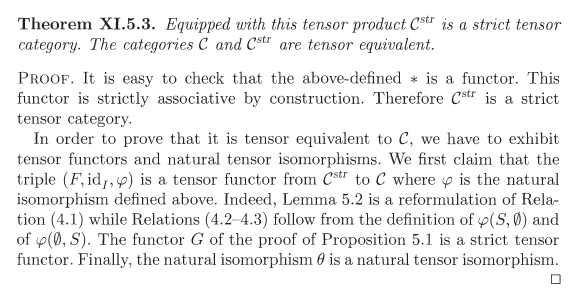I'm reading the book "Quantum groups" by Kassel. I'm reading the proof that every tensor category is tensor equivalent with a strict tensor category. Here is the proof given. Below is more context.
The functor $G: \mathcal{C}\to \mathcal{C}^{str}$ is given by $G(V) =(V)$. However, I believe $G$ is NOT strict since $$G(U \otimes V) = (U \otimes V) \neq (U,V) = (U)*(V) = G(U)*G(V)$$
Is there a way to fix this proof? Maybe $G$ is not a strict tensor functor but still a tensor functor that gets the job done?
If not, can someone give a reference where this "finite sequence" approach to constructing the strict tensor category works?
Here is more contextmore context:
Let $\mathcal{S}$ be the class of finite sequences $(V_1, \dots, V_k)$ of objects in $\mathcal{C}$. We include the empty sequence $\emptyset$. The integer $k$ is by definition the length of the sequence. If $S= (V_1, \dots, V_k)$ and $S' = (W_1, \dots, W_l)$ are non-empty finite sequences, then we define $S*S' := (V_1, \dots, V_k, W_1, \dots, W_l)$. We also define $S*\emptyset = S = \emptyset*S$ for every finite sequence $S \in \mathcal{S}$.
We now associate to every $S \in \mathcal{S}$ an object $F(S) \in \mathcal{C}$. We give an inductive definition (recursion on the length of the finite sequence).
$F(\emptyset) = I$
$F((V)) = V$, $\quad V \in \mathcal{Ob} \mathcal{C}$
$F(S*(V)) = F(S) \otimes V$, $\quad S \in \mathcal{S}\setminus \{\emptyset\}, V \in \mathcal{Ob} \mathcal{C}$
More generally, if $(V_1, \dots, V_k) \in \mathcal{S}$, we get $$F((V_1, \dots, V_k)) = (\dots((V_1 \otimes V_2) \otimes V_3) \otimes \dots )\otimes V_{k-1})\otimes V_k$$
We can now define the category $\mathcal{C}^{str}$. This is the category determined by:
$\mathcal{Ob} \mathcal{C}^{str}= \mathcal{S}$
$Hom_{\mathcal{C}^{str}}(S,S') = Hom_\mathcal{C}(F(S), F(S')), \quad S,S' \in \mathcal{S}$
Composition of morphisms in $\mathcal{C}^{str}$ is simply the composition of the corresponding morphisms in $\mathcal{C}$.
__
The functor $G: \mathcal{C} \to \mathcal{C}^{str}$ is defined by $G(V) = (V)$ and $G(f) = f$.

